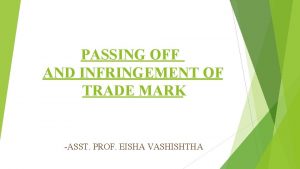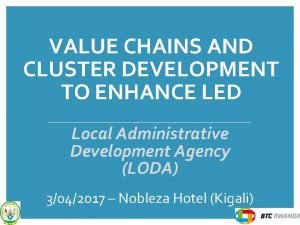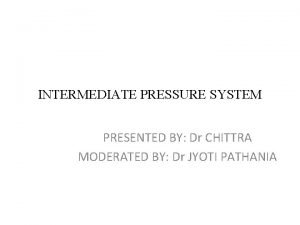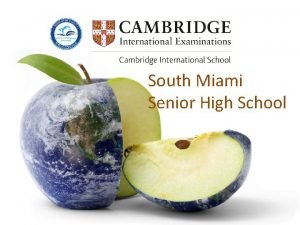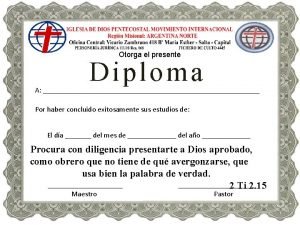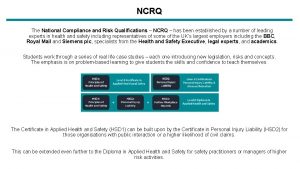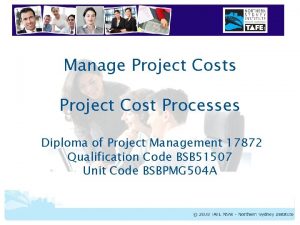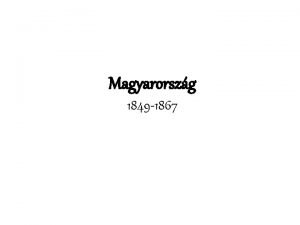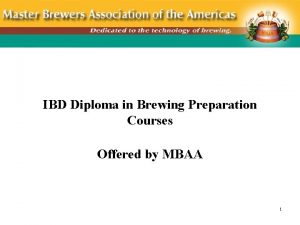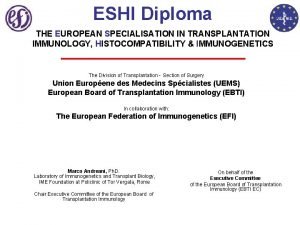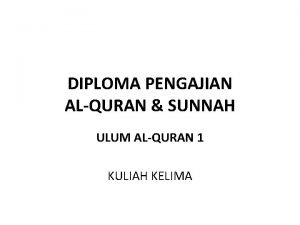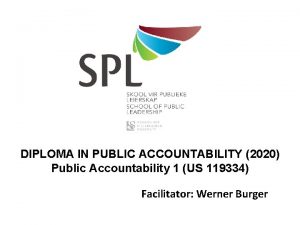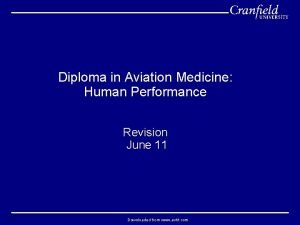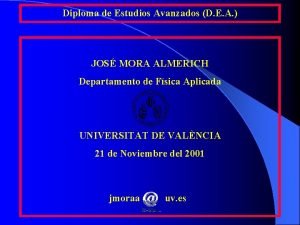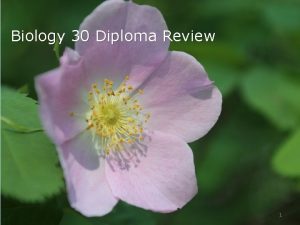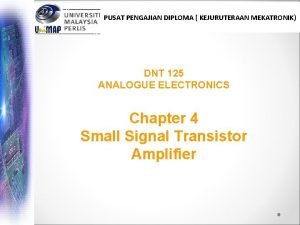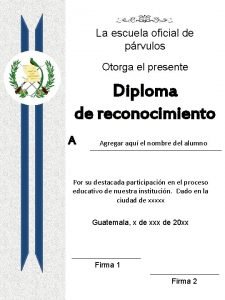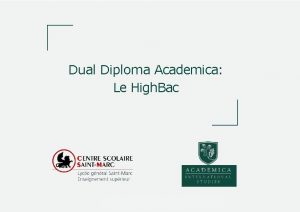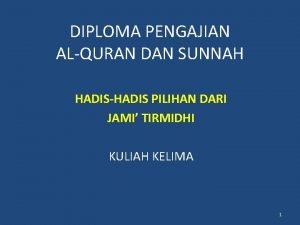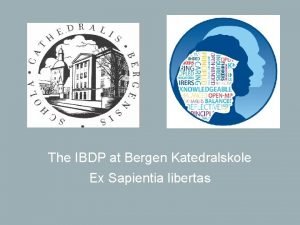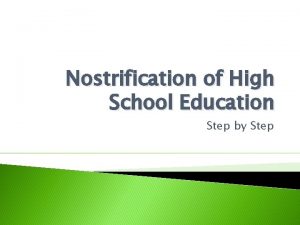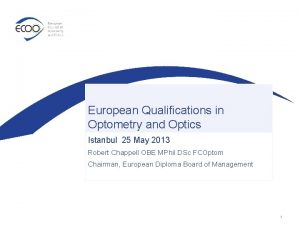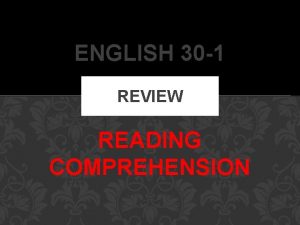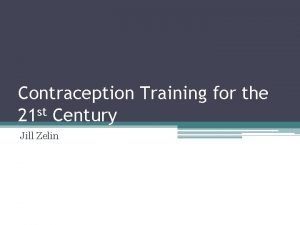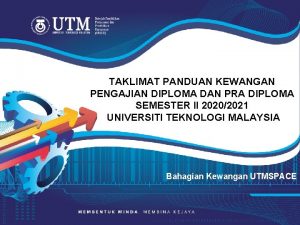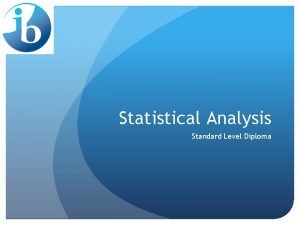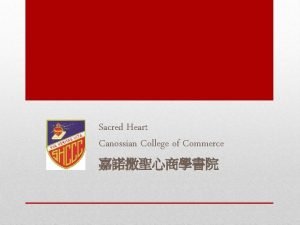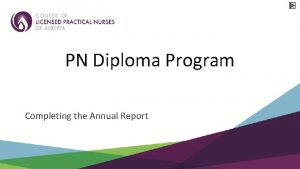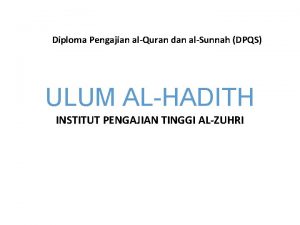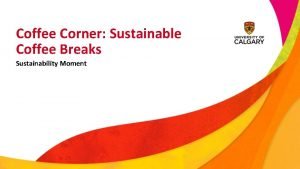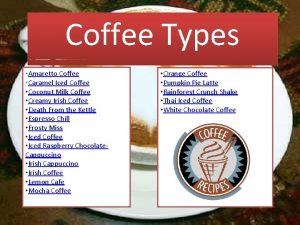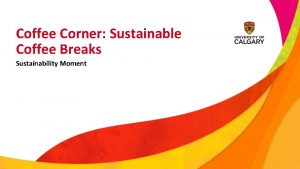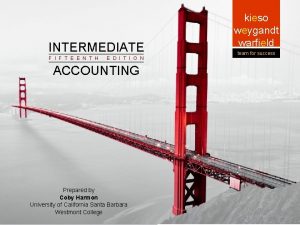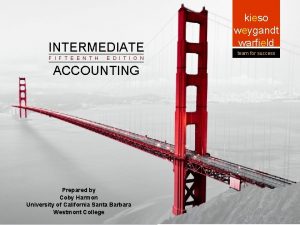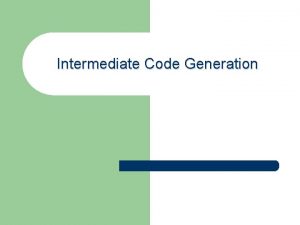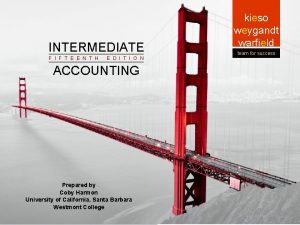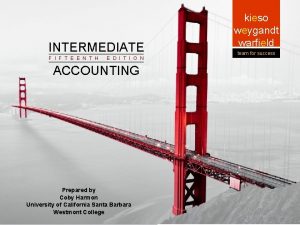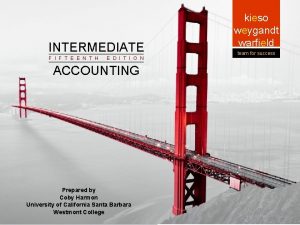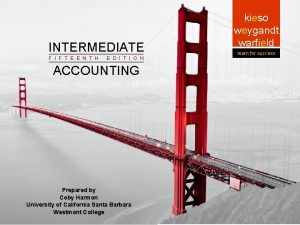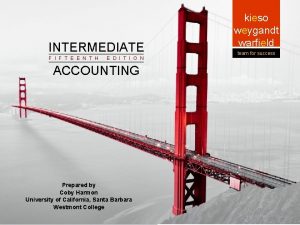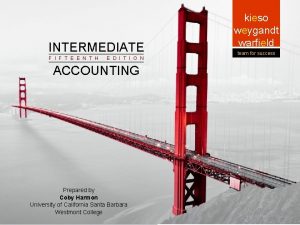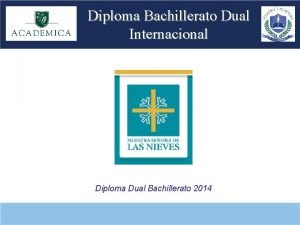Green coffee course Green INTERMEDIATE Coffee Diploma System






































































- Slides: 70

Green coffee course Green INTERMEDIATE Coffee Diploma System SCAE

Presentazioni Ph. D Andrej Godina Science, Technology and Economy in the Coffee Industry Università degli Studi di Trieste

Educational Campus Umami Barista Camp Florence

What’s Coffee Diploma System?


SCAE Our Vision: to be the authority on delivering coffee excellence Our Mission: to create and inspire excellence in the coffee community through innovation, research, education and communication Our Values: excellence, knowledge, leadership, integrity, communication, competence, education and community www. scae. com


World Coffee Events is the premier producer of events for the coffee community and licenses national championships in more than 60 countries involving thousands of participants worldwide. The World Coffee Events’ mission is to develop events that engage the specialty coffee community and promote coffee excellence.

Introduction to Coffee is an ideal module for anyone who is new to the coffee industry or just has an interest in this wonderful drink. It charts coffee’s journey from its origins in Ethiopia to the major commodity it is today, enjoyed by millions of people around the world. From farming the cherries through drying, roasting, brewing and finally drinking, this module looks at the processes coffee goes through. This half day course also includes a “coffee cupping” which allows you to taste the various flavours coffee has to offer.

The Green Coffee module covers the key concepts surrounding green coffee, from growing the plant, through processing, shipping, storage and arrival at a roaster. It includes principles of coffee growing, processing and green coffee grading and coffee contracts and green coffee portfolio management. Intermediate looks at green coffee in greater detail and builds on the core vocational skills needed by people who work with green coffee on a daily basis. It is broken down into three areas: Principles of coffee growing and processing; Introduction to green coffee grading; Coffee contracts and green coffee portfolio management.

Sensory Skills teaches you the essentials of sensory evaluation in a practical and interactive manner. It investigates the way we perceive what we taste and how to apply this knowledge when evaluating coffee’s natural characteristics. It also offers an insight into identifying speciality coffee qualities, as well as an overview of how to implement this in business. Intermediate is ideal for someone already working in the area who wants to develop their knowledge of sensory skills. It is broken down into three areas: How we taste, perceive and interpret; Running a cupping session and tasting the diversity of coffee; How to set up sensory skills in your business.

Roasting gives you an understanding of the roasting process, including the roast cycle and how to control sensory aspects of the coffee by roasting light or dark. In addition, this module covers roast defects, the physical changes that beans undergo during the roasting process, as well as workspace management and lean production. Intermediate builds on the basics covered in Foundation and covers roast defects, the physical changes that beans undergo during the roasting process, as well as workspace management and lean production.

The study of Brewing introduces you to the different ways of brewing coffee, from Chemex and siphon to clever dripper and French press. In addition, this module allows you to get hands-on and learn to analyse your grind profile, match your grind to your brewing method and to scientifically measure coffee strength and chart a coffee’s extraction. Intermediate is very much a hands-on workshop where you will learn to analyse your grind profile, match your grind to your brewing method and to scientifically measure coffee strength and chart a coffee’s extraction.

Barista Skills is for people focussing on the key skills required to set your grinder, make espresso and foam and texture milk for cappuccinos. This module allows you to gain a deeper understanding of the coffee itself and build on your practical skills for milk technique and latte art, not to mention health and safety, customer service and basic business. Intermediate provides a deeper understanding of the coffee itself and builds on the practical skills learnt at Foundation level. Milk techniques, including latte art, are introduced as well as health and safety, customer service and basic business. This course is suitable for people already working as baristas.

www. scae. com

Green intermediate

History Coffea Arabica is indigenous of Etiopia area, Coffea Canephore born in central-west Africa.




Coffee plant The coffee plant is a tree belonging to the Rubiacee family. The tree can rich height of up to 15 meters but in coffee plantations is cultivated as a 2 -3 meters. There are 4 main coffee species cultivated: Arabica, Canephora, Excelsa, Liberica. Arabica and Robusta are the most important economically. Robusta is a Canephora’s variety, as the Conillon. The Arabica has over 80 variets as Bourbon , Maragogype, Typica, Caturra, Catuai, Catimor, Mundo Nuovo.



Ideal climate At the equator the suitable altitude range for Arabica production is 1000 -2000 m on the sea level, for Robusta is 0 -1000 m. Arabica tree is particulary sensitive and non frost resistant, temperature must not fall below freezing (0°C). Robusta is far more resistant, produce more higher crop yields, and is able to handle more hot and wet climate. Coffee trees can live up to 50 years old, crop yields begin to diminish after about 20 years.

Altitude and cup profile The coffee physically becomes denser and harder if grown at altitude, with a narrower centre cut after roasting. Studies in Nicaragua by CATIE have shown that altitude is the strongest factor associated with a range of positive cup characteristics, and in particular, acidity, body, flavours and balance. During harvesting, the ripe cherry moisture content is around 60 -65%.


Mragagogype variety produce the “giant beans” in other words beand up to 20 screen. Pacamara and Maracaturra are cross variety between Maragogype and Pacas and Caturra. .


The Arabica production is about 60% of the total coffee prduction.

The biggest Arabica producing country is Brazil, the Robusta one is Vietnam. The impact of a severe frost on coffee tree is that the tree die and/or the cherry become black.

From a small coffee farmer from in India: I live on my farm which is in Kodagu district of Karnataka State in India. My farm is at an elevation of 2900 ft above sl. I grow 99% Robusta and 1% Arabica. My Robusta is of two varieties Selection No. 274 and Selection 3 R (C X R). C X R is a cross between Congensis and Robusta. The coffee is completely shade grown. The coffee grows among a lot of wild fruit trees, jungle wood and spices like pepper and chilly. Though the plants get a lot of nourishment from the fallen leaves I also provide Urea, DAP, MOP, inorganically and Boron, Zinc, Sulphur, etc. as micronutrients. There is zero use of pesticides and insecticides for coffee although I use a bordeaux mixture for my pepper vines. The coffee is completely natural processed and sent to our cooperative society for hulling and garbling. Although I am inviting in a coffee pulper this year and will start wet processing my coffee this year. I have attached a few photographs for your perusal. I hope I have answered your questions satisfactorily. Please let me know if you need any more information. abbharath@gmail. com



Green vocabulary Bóia: Cherry coffee separated by virtue of it being positively buoyant in water applied to a one-pass stripping harvest system where there is abundant tree-dried cherry. Cherry (or Coffee cherry): The complete fruit of the coffee tree, can be either fresh or dry. Conditioning: The storage of dried beans in ventilated bins to achieve an even moisture content within the bulk of the coffee. Conditioning bin: Large wire-mesh holding bins usually of 1 x 3 m (or larger) that are used for conditioning coffee. Modern designs incorporate fan ventilation. Curing: The final stage of preparing coffee, known as 'curing', usually takes place just before the coffee is sold for export. Coffee passes through a number of operations that may include cleaning, polishing, screening, sorting and grading.

Defects: The collective name for common but undesirable particles found in bulk green coffee. Defects can include various types of beans, or parts of beans, fruit tissue and foreign matter. Numerous terms are used to describe the various defects that can be present in both green/raw and roasted coffee beans, and sometimes these are used in some producing countries and not others. In general, bean defects are caused by faulty processing, pest damage, or inclement climatic conditions leading to poor fruit development. Defects are given a weighted value to assist in the classification and grading of coffee lots under various national and international systems. Dry processing: Treatment consisting of drying coffee cherries to give husk coffee, followed by mechanical removal of the dried pericarp to produce green coffee. The product is called ‘cherry coffee’, ‘unwashed coffee’ or ‘natural coffee’. Floats coffee: Cherry coffee separated by virtue of it being positively buoyant in water applied to selectively picked coffee the vast majority of which is ripe or immature.

Gleaning (or Sweeping): Applies to the collection of coffee fruit found lying on the ground beneath coffee bushes, having either become detached during harvest or abscised during development. ‘Gleanings’ is the collective term for coffee collected in this manner. Green coffee bean: The dried seed of the coffee plant, separated from non-food tissues of the fruit. Coffee is exported in this form. Hull: The dried endocarp of the coffee fruit. Husk: Waste material resulting from the hulling of parchment or dry cherry coffee, made up of the dried pulp and outer covering of the parchment. Mbuni (or Buni): Cherry coffee that has been separated from selectively harvested fruit based on visual criteria such as evidence of CBD or CBB attack or being at a non-ripe stage of maturity (Note: ‘Bun’ or ‘Buni’ is also the generic name for coffee in Ethiopia, and is not to be confused with ‘mbuni’).

Mechanical drying: Any of several drying technologies where heat is provided from combustion of a fuel. Mechanical washing: Any of the mechanical methods for removing the mucilaginous mesocarp from the surface of the parchment, taking place after pulping without a fermentation step. Mucilage: Common word to describe the fruit mesocarp, an intermediate layer of tissues between the epicarp and the endocarp (parchment). It consists mainly of pectinaceous mucilage and pulp. Naked beans: Parchment coffee that has been partly or entirely peeled of its parch during pulping and/or washing. Natural processing: See ‘Dry processing’. Parchment (or Parch): Common word to describe the endocarp of the coffee fruit. It lies between the fleshy part (or pulp) of the cherry and the silver skin. This is the thin, crumbly paper-like covering that is left on wetprocessed coffee beans after pulping and fermentation. Subsequently removed during hulling.

Parchment coffee (or Pergamino): Wet-processed beans after pulping, dried to about 12% moisture content, but before hulling has removed their hard outer covering (the endocarp/parchment). Processing: Steps involving the transformation of harvested coffee fruits to a dry and stable condition. Pulp: The fleshy outer layer of the mesocarp, directly beneath and including the skin, removed with a pulping machine Pulping: Mechanical treatment used in wet processing to remove the exocarp and as much of the mesocarp as possible Wet process (or Wet processing): A method of processing coffee cherries into dried pergamino/parchment coffee. Treatment consists of mechanical removal of exocarp in the presence of water, removal of all the mesocarp by fermentation or other methods, and washing followed by drying to produce parchment coffee which is subsequently stripped of its parchment to produce green coffee.

The harvesting methods are: Picking Stripping Mechanical

Processing methods Washed: as the coffee cherries can only be stored for an extremely short time they have to processed as quickly as possible after being harvested. • Cherries are cleaned and pre-sorted in water tanks • Depulping allow to separate the skin and pulp from the parchments • The mucilage attached on the parchment is removed throught fermantation (12 -36 hours) and mechanical removal, chanelling: ensuring mucilage is fully removed after fermentation, initial density separation of wet parchment coffee to separate coffees of different potential value. • Drying: until reaches the moisture level of 12%

Processing methods Natural: the sorting phase in water at the begin let to separate the floaters from the ripened cherries. Then the ripe cherries are dried under the sun: the climate have to be warm and sunny. This processing method is most used where the water is very expensive and scarce. Usually the process ends in 3 -4 weeks; It’s possibile to dry coffee quicker using mechanical driers but it’s more expendive.

Processing methods Semi-washed: ripe coffee beans are separeted from the pulp in the pulper but spread out to dry afterwards in their parchment still covered in the mucilage. The beans have to be turnerd often preventing fermentation, the process takes about 7 -8 days. Pulped-natural: the ripe berries are dried and whne are still enough soft are pulped. Then the parchment is still dried until it reaches the right moisture level.

Processing methods Highness for natural drying beds: 5 cm Highness for parchment drying beds: 2, 5 cm Why the mucilage is removed in wet process? During the initial skin drying the presence of the mucilage means it is harder to turn pulped natural coffees. Because of this they demand extra care to ensure coffee does not clump together and produce off flavours or mould.

Before export the coffee beans are sorted, after parchment is removed. The defected beans are removed manually and with mechenical equipment as the gravity separator (it’s used to remove defects linked to less dense beans including fermented beans, insect damaged beans, malformed beans and some black beans). Coffees are rested at 12% to allow a safe level of moisture to equilibrate through the bean and to improve cup quality (less astringent)

Moisture measurement OWEN DRYING at 105°C Using a MOISTURE meter ICO – International Coffee Organization suggest a moisture level range for specialty coffees of 8 - 12, 5%.

Coffee screens Coffee beans size are measured using the coffee screens. The first and smallest coffee screen is the number 9 and the biggest one is number 20. The number of the screen indicates the diameter of the hole and it’s measured in 64 th of an inch (2, 54 cm).

Coffee defects A visual coffee defect is anything that diverges from a normal bean inside the lot and that can be produced in the field or during the harvest, processing, transport or storage.

Coffee defects

Coffee defects See the coffee SCAA defect handbook.

Coffee storing and shipment During storing it’s important to keep temperature and RH at certain levels in order to keep the coffee quality. During shipment in container it’s important to prevent excessive moisture levels with the following: • Lining the container with kraft paper • Using ventilated containers • Placing packs of vermiculite (e. g. silica) around the container • Ensuring coffee transit times are short, particularly in the section of the journey in a producing country.

Coffee storing and shipment OTA (Ochratoxin A) is a mycotoxin found in green coffee produced by species of fungi. It occurs in coffee as a result of poor hygiene and quality control in post-harvest processing. A mycotoxin is a toxic secondary metabolite produced by organisms of the fungi kingdom, commonly known as molds. The term 'mycotoxin' is usually reserved for the toxic chemical products produced by fungi that readily colonize crops. One mold species may produce many different mycotoxins, and the same mycotoxin may be produced by several species.

Coffee shipment The bill of lading is the title deed for coffee on a ship.

Coffee shipment The Incoterms rules or International Commercial Terms are a series of pre-defined commercial terms published by the International Chamber of Commerce (ICC). They are widely used in International commercial transactions. A series of three-letter trade terms related to common contractual sales practices, the Incoterms rules are intended primarily to clearly communicate the tasks, costs, and risks associated with the transportation and delivery of goods.


Incoterms

International coffee market There are two main futures market centres, New York and London, serving the global coffee industry: • In New York, the Intercontinental Exchange (NYSE: ICE), for arabica (the New York C Contract – market symbol KC) – see www. theice. com. • In London, the London International Financial Futures and Options Exchange (NYSE Liffe), for robusta (market symbol RC) – see www. euronext. com. Other futures markets trading in coffee are found in Brazil and Singapore, whereas Viet Nam inaugurated two domestic exchanges in 2011.

Terminology First hand – coffee sold from/by origin. Second hand – coffee subsequently sold on by overseas traders. Spot – immediately available coffee. Futures market – trades standard qualities and quantities of coffee for future delivery at pre-determined ports during specific months or trading positions. Differential – premium or discount of ‘our coffee’ with respect to the futures market. Outright sale or fixed price sale – the full selling price is set at the time of sale. PTBF – price to be fixed: selling now at a known differential against the futures market with the futures price being determined later. Fixing – the action to determine the futures price that, combined with the differential, will become the contract price for the physical coffee. PTBF seller’s call – futures price to be called or fixed by the seller. PTBF buyer’s call – futures price to be called or fixed by the buyer. Basis risk or differential risk – the risk that the differential moves against us.

Outright price Before active futures markets came into being coffee was bought and sold at fixed prices, meaning purchase and sale contracts would show a simple amount per pound or per ton. This type of pricing is also called ‘outright’ pricing. If one bought coffee at US$ 1. 60/lb that had not already been sold (bought long), one could only hope and pray that the price would stay the same or go higher. If one sold coffee at US$ 1. 60/lb that had not already been bought (sold short), the hope would be that the price would stay the same or go down in value. Anytime you closed such a contract, you were totally exposed to any price movements in the coffee market.

Price to be fixed When the market outlook is very uncertain, many traders and roasters are reluctant to purchase physical coffee outright on a forward basis. The international trade has therefore developed a system of selling coffee without specifying a price for it, i. e. at a price to be fixed (PTBF). A relevant delivery month of the futures market is chosen: its price at a given moment will determine or fix the price of the physicals contract. If the quality of the physicals is worth more or less than the quality on which the futures contract is based, the price stipulation will read (for example) 'New York "C" December plus (or minus) 3 cts/lb', or 'London robustas November plus (or minus) US$ 30/ton': the plus 3 or plus 30 is the differential.

Price to be fixed The contract constitutes a firm agreement to deliver and accept a quantity of physical coffee of a known quality and under established conditions. These conditions are based on the quotation for the specified delivery month of the futures market at the time of fixing, plus or minus the agreed differential. The advantage to the buyer and seller is that each has secured a contract for physical coffee, but the price remains open. The system of PTBF has been honed to such an extent that prices are sometimes fixed only when coffee is delivered to the roaster's premises.

Decaffeinated coffee Green coffee can be decaffeinated using various extraction processes, which can mostly be differentiated based on the solvent used for the extraction. The processing stages apply to all the various methods, and include: • Steaming: The coffee is treated with water and steam, which starts the extraction process and makes the beans expand. This stretches the cellular structure within each bean, and therefore facilitates the extraction of the caffeine. • Extraction: The coffee is then rinsed with a specific solvent, which 'captures' the caffeine and removes it from the bean.

Decaffeinated coffee • Recovery of the solvent: Almost all of the solvent can be recovered from the coffee, and can then be re-used. This stage is carried out with great care both for financial reasons (all the products used are very expensive and so waste must be kept to a minimum) and for legal reasons, since there are legal limits concerning the maximum quantity of residue. • Moisture removal: Almost all of the moisture in the coffee is removed. • Packing: The coffee is packed into its original bags or into new bags provided by the client.

Decaffeinated coffee • Testing: The coffee's residual caffeine content (not in excess of 0. 1% allowed by law in Italy and most of Europe), residual solvent content (not in excess of 2 p. p. m. of dichloromethane for roasted coffee) and moisture content (no higher than of 11% allowed by Italian law) are tested. http: //www. demus. it/en/pagina/la-decafeinizzazione. htm

Decaffeinated coffee Solvents: Water: using water as a solvent has excellent commercial appeal, and in fact it was one of the first solvents to be used for decaffeination. It is rather complicated to use because it is not particularly selective, so it extracts some of the water soluble flavour components from the product, along with the caffeine. Ethyl acetate is a selective solvent for caffeine and a natural component of many fruits, and it is therefore well thought of amongst consumers (actually extraction processes use mainly a synthetic version).

Decaffeinated coffee Supercritical CO 2: this process is conducted at extremely high pressure and high temperatures, which cause the carbon dioxide to pass into its supercritical state, with properties midway between a liquid and a gas. Dichloromethane is the most widely used solvent for decaffeinating green coffee. Dichloromethane is a very volatile substance (it evaporates at 40°C) which acts selectively on caffeine and is relatively easy to remove from coffee through steam.

Green coffee certifications Rainforest alliance: Integrates biodiversity, conservation and community development, workers’ rights and productive agricultural practices to ensure comprehensive sustainable farm management. http: //www. rainforest-alliance. org/work/agriculture/coffee

Green coffee certifications Faitrade: Supports a better life for farming families through fair prices, direct trade, community development and environmental stewardship https: //fairtrade. com/farmers/fairtrade-coffee

Green coffee certifications UTZ Kapeh: enhances economic social and environmental production, processing and trading conditions to all who make a living in the coffee sector. https: //www. utzcertified. org

Green coffee certifications 4 C – coffee code: achieves sustainable agricultural supply chains fostering good practice (producers), demanding and rewarding sustainably grown products (food industry) and social and environmental responsibility (consumers). http: //www. 4 c-coffeeassociation. org

Thanks for you kind attention aj. godina@umamiarea. com
 Starbucks vs sardarbuksh case
Starbucks vs sardarbuksh case Vertical integration meaning
Vertical integration meaning Diploma in project management course outline
Diploma in project management course outline Red green show
Red green show Pure green coffee
Pure green coffee Half brick wall vs one brick wall
Half brick wall vs one brick wall Course number and title
Course number and title Course interne course externe
Course interne course externe Intermediate pressure system
Intermediate pressure system Anesthesia machine lecture
Anesthesia machine lecture Ia diploma resp
Ia diploma resp Avinash college of commerce intermediate fee structure
Avinash college of commerce intermediate fee structure Ib diploma requirements
Ib diploma requirements Diploma a super mama
Diploma a super mama Franklin high school regina marquez-martinez
Franklin high school regina marquez-martinez What is aice
What is aice El presente diploma
El presente diploma Ncrq national compliance and risk qualifications
Ncrq national compliance and risk qualifications Project costing diploma
Project costing diploma Schmerling féle provizórium
Schmerling féle provizórium International skills diploma seal
International skills diploma seal Diploma in brewing
Diploma in brewing Double dogwood diploma
Double dogwood diploma Hong kong diploma of secondary education
Hong kong diploma of secondary education Grade 10 orientation
Grade 10 orientation Etsu registration office
Etsu registration office Immunology diploma
Immunology diploma Diploma pengajian islam
Diploma pengajian islam Berikut yang tidak termasuk adab membaca alquran adalah
Berikut yang tidak termasuk adab membaca alquran adalah Diploma in public accountability
Diploma in public accountability Diploma in aviation medicine
Diploma in aviation medicine Diploma fin curso
Diploma fin curso Dea diploma
Dea diploma American diploma project
American diploma project Unit 3 group performance workshop
Unit 3 group performance workshop Biology 30 diploma with answers
Biology 30 diploma with answers Obp hesaplama
Obp hesaplama Cache 3 diploma
Cache 3 diploma Pwcs specialty programs application
Pwcs specialty programs application Diploma mekatronik
Diploma mekatronik Grade 9 diploma
Grade 9 diploma Orvosi diploma honositasa magyarorszagon
Orvosi diploma honositasa magyarorszagon Otorga el presente diploma
Otorga el presente diploma Ib diploma requirements 2021
Ib diploma requirements 2021 Grade 9 diploma
Grade 9 diploma Online culinology diploma
Online culinology diploma High bac
High bac Diploma alquran dan sunnah
Diploma alquran dan sunnah Diploma in funeral arranging and administration
Diploma in funeral arranging and administration Diploma in funeral arranging and administration
Diploma in funeral arranging and administration Diploma in funeral arranging and administration
Diploma in funeral arranging and administration Diploma quran dan sunnah
Diploma quran dan sunnah Sapientia et libertas
Sapientia et libertas Stem diploma
Stem diploma Nostrification of high school diploma
Nostrification of high school diploma Baccalaureate diploma
Baccalaureate diploma European diploma in optometry
European diploma in optometry Reading comprehension part 1
Reading comprehension part 1 Ayurvedic lifestyle consultant
Ayurvedic lifestyle consultant Fsrh diploma cost
Fsrh diploma cost The honesty diploma
The honesty diploma Ubc teacher librarianship
Ubc teacher librarianship Elearning utmspace
Elearning utmspace Diploma in statistics
Diploma in statistics Kpk logo
Kpk logo Sacred heart canossian college
Sacred heart canossian college Almanya denklik danışmanlık
Almanya denklik danışmanlık Diploma annual report
Diploma annual report Idta level 4 diploma
Idta level 4 diploma Diploma in reproductive medicine
Diploma in reproductive medicine Diploma pengajian al quran dan sunnah separuh masa
Diploma pengajian al quran dan sunnah separuh masa
